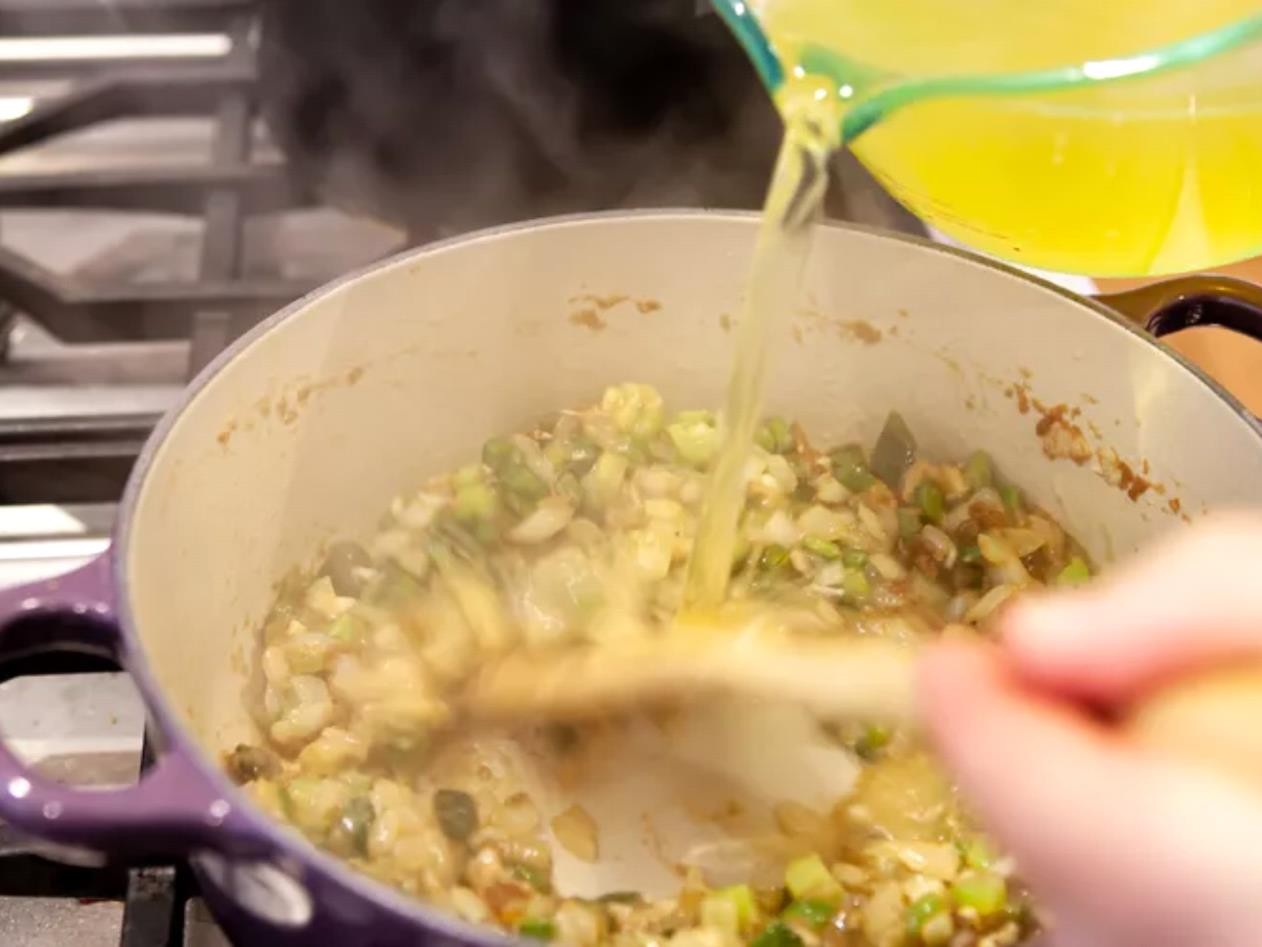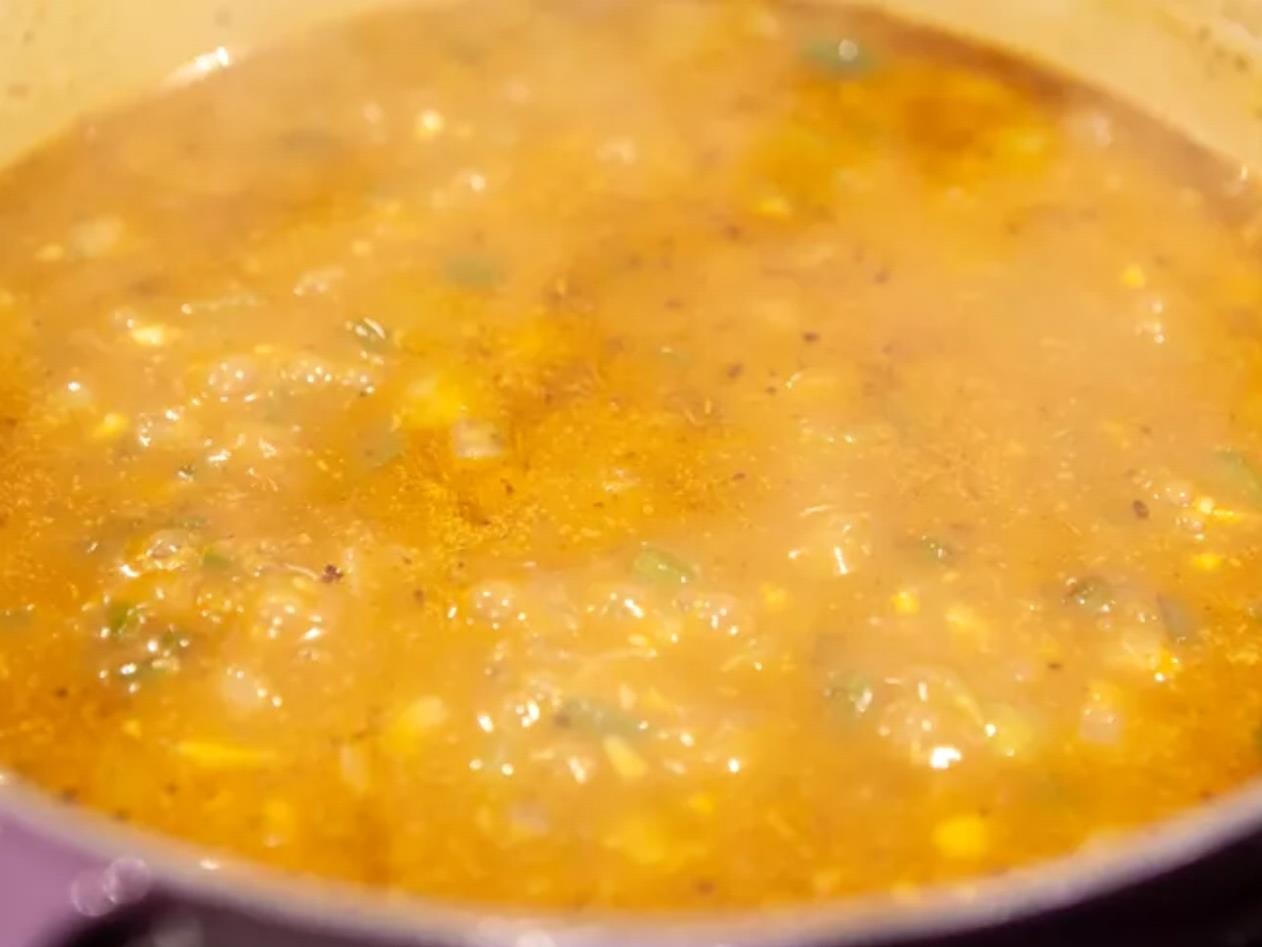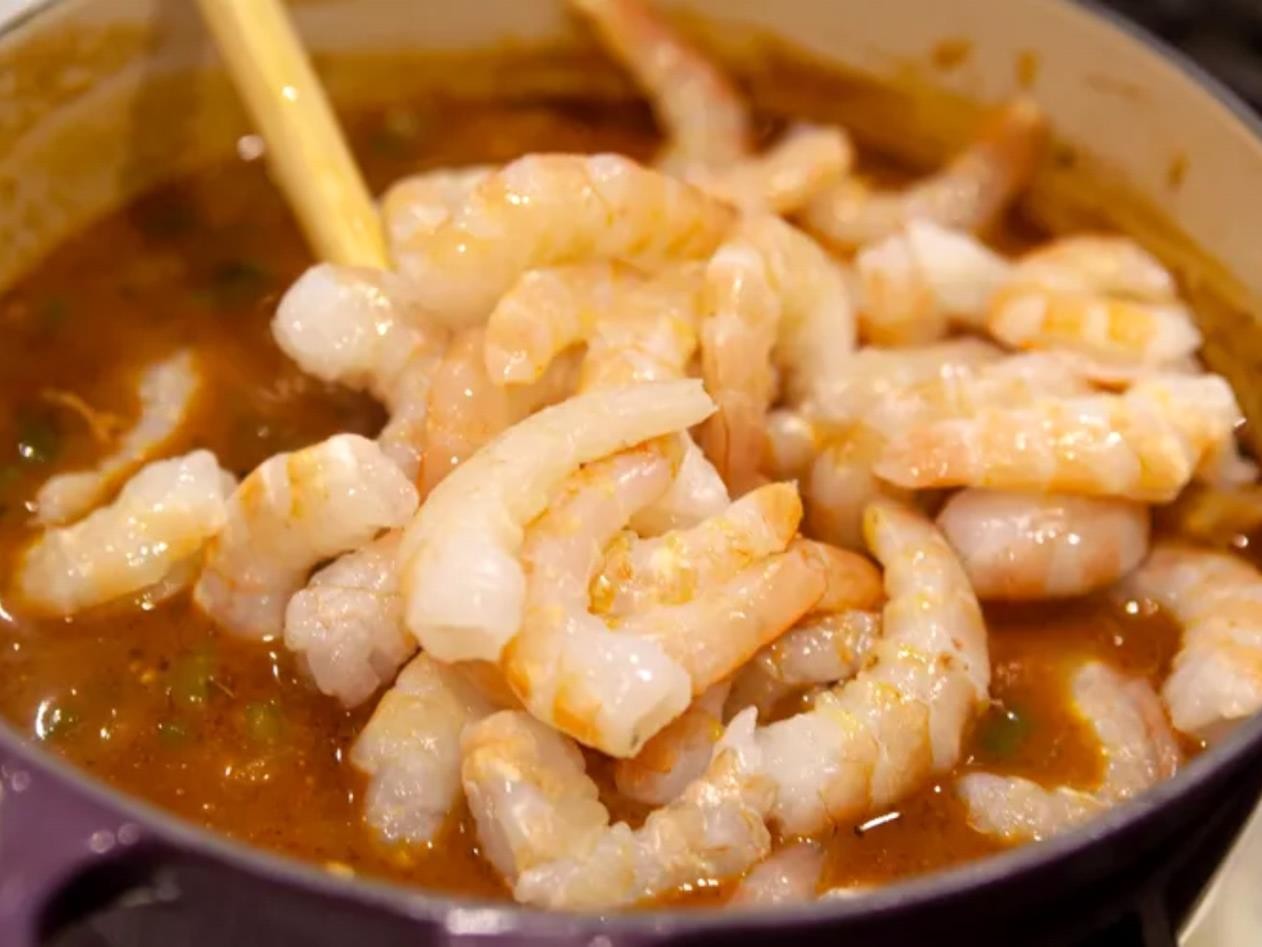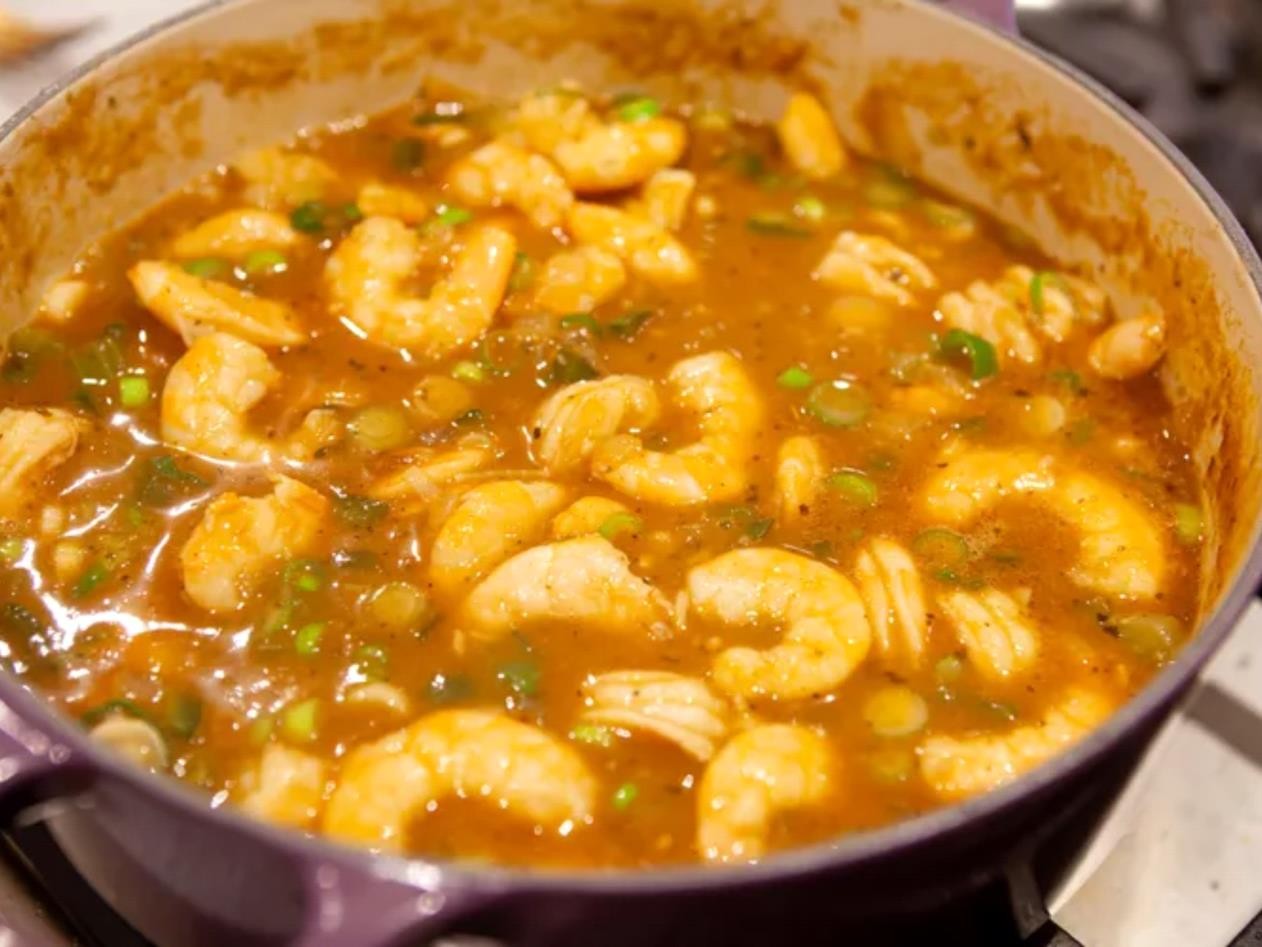Shrimp and Crawfish Etouffee is a delectable Cajun dish that showcases the rich and robust flavors of Louisiana cuisine. This savory dish features a luscious medley of succulent shrimp and tender crawfish tails smothered in a flavorful roux-based sauce. The etouffee is further enhanced with the holy trinity of Cajun cooking, consisting of onions, bell peppers, and celery, along with a harmonious blend of spices and seasonings. The dish is traditionally served over a bed of steamed rice, allowing the flavors to mingle and create a truly satisfying experience. With its combination of seafood, aromatic vegetables, and a velvety sauce, Shrimp and Crawfish Etouffee embodies the heart and soul of Cajun comfort food, promising a taste sensation that will transport you straight to the bayous of Louisiana.
Ingredients for Shrimp and Crawfish Etouffee
Ingredients for Shrimp Stock:
⦁ – Shells from 2 pounds of shrimp
⦁ – 1/2 large onion, chopped
⦁ – Top and bottom from 1 green pepper
⦁ – 2 garlic cloves, chopped
⦁ – 1 celery rib, chopped
⦁ – 5 bay leaves
Ingredients for Étouffée:
⦁ – 1/4 cup vegetable oil or lard
⦁ – 1/4 heaping cup flour
⦁ – 1 large rib celery, chopped
⦁ – 1 green bell pepper, chopped
⦁ – 1 to 2 jalapeño peppers, chopped
⦁ – 1/2 large onion, chopped
⦁ – 4 garlic cloves, chopped
⦁ – 1 pint shrimp stock, clam juice, or fish stock
⦁ – 1 tablespoon Cajun seasoning
⦁ – 1/2 teaspoon celery seed
⦁ – 1 tablespoon sweet paprika
⦁ – Salt, to taste
⦁ – 2 pounds shrimp, peeled (save the shells for shrimp stock)
⦁ – 3 green onions, chopped
⦁ – Hot sauce, such as Crystal or Tabasco, to taste
Steps to make Shrimp and Crawfish Etouffee
Step 1
If you don’t have shrimp stock ready, start by taking the shells from 2 pounds of shrimp and combine them with chopped onion, green pepper, garlic cloves, celery rib, and bay leaves in a pot with 2 quarts of water. Bring the mixture to a boil, then reduce the heat and let it simmer for approximately 45 minutes. Afterward, strain the stock through a fine-mesh sieve into another pot placed over low heat. Keep in mind that you’ll need about 2 cups of stock for this recipe, and any extra can be used for other dishes or stored in the refrigerator for a week or in the freezer for up to three months.
Step 2
In a heavy pot, heat the vegetable oil or lard over medium heat for a couple of minutes. Add the flour to the pot and stir continuously to ensure there are no clumps. Let the mixture cook, stirring often, until it turns a deep brown color, which should take around 10 minutes. This roux will provide a rich and thick base for the étouffée.
Step 3
Next, add the chopped celery, green pepper, jalapeño peppers, and onion to the pot with the roux. Mix everything well and cook over medium heat for approximately 4 minutes, stirring occasionally. Then, add the chopped garlic and cook for an additional 2 minutes. The combination of these aromatic vegetables will enhance the flavors of the dish.
Step 4
Measure out 2 cups of the prepared shrimp stock and slowly add it to the pot, little by little, while stirring constantly. At first, the roux may absorb the stock and thicken, but as you continue adding more, it will loosen up. Adjust the consistency by adding additional stock as needed until you achieve a sauce-like thickness, similar to syrup. Once the stock is fully incorporated, add the Cajun seasoning, celery seed, and sweet paprika. Mix well to distribute the flavors throughout the dish. Season with salt to taste, and then add the peeled shrimp to the pot. Cover the pot, reduce the heat to its lowest setting, and let it cook for 10 minutes to allow the shrimp to cook and the flavors to meld together.
Step 5
After the shrimp has cooked for 10 minutes, it’s time to add the final touches to your étouffée. Stir in the chopped green onions, which will provide a fresh and vibrant flavor to the dish. If you prefer a spicier kick, add hot sauce according to your taste preferences. Stir well to incorporate all the ingredients and allow the flavors to meld together.
Now your shrimp étouffée is ready to be served! It pairs beautifully with white rice, which will absorb the flavorful sauce and complement the shrimp perfectly. Consider serving it alongside a cold beer or refreshing glass of lemonade to balance the richness of the dish. The combination of succulent shrimp, aromatic vegetables, and bold seasonings will create a satisfying and memorable meal. Enjoy!
Nutrition Facts
⦁ – Calories: 317
⦁ – Total Fat: 13g (16% DV)
⦁ – Saturated Fat: 2g (8% DV)
⦁ – Cholesterol: 320mg (107% DV)
⦁ – Sodium: 2200mg (96% DV)
⦁ – Total Carbohydrate: 12g (4% DV)
⦁ – Dietary Fiber: 2g (6% DV)
⦁ – Total Sugars: 2g
⦁ – Protein: 38g
⦁ – Vitamin C: 33mg (166% DV)
⦁ – Calcium: 170mg (13% DV)
⦁ – Iron: 2mg (8% DV)
⦁ – Potassium: 535mg (11% DV)
*Percent Daily Values (% DV) are based on a 2,000-calorie daily diet. The DV indicates how much a nutrient in a serving of food contributes to your daily intake.
These nutritional values provide a snapshot of the nutrient composition of the shrimp étouffée. It contains a moderate amount of calories, with 317 per serving, and is a good source of protein, providing 38g per serving. The dish also contains a moderate amount of fat, primarily from the shrimp, with 13g per serving. Saturated fat is present in smaller quantities, at 2g per serving.
In terms of cholesterol, the shrimp étouffée is higher due to the shrimp content, with 320 mg per serving. The dish is seasoned with Cajun spices and contains sodium at 2200 mg per serving. It also offers dietary fiber, vitamins, and minerals, including vitamin C, calcium, iron, and potassium.
People also Read
Delicious Butterfly Shrimp Recipe In 3o Minutes
Delicious Zatarain’s Dirty Rice Recipe 2023
How to make California roll filling
Steps to avoid while preparing of Shrimp and Crawfish Etouffee
1. Avoid overcooking the seafood: Shrimp and crawfish can become tough and rubbery if they are cooked for too long. Be careful not to overcook them, as they will continue to cook slightly in the hot sauce after they are added. Cook them just until they turn pink and are no longer translucent.
2. Don’t burn the roux: When making the roux, it’s important to stir it constantly and cook it over medium heat to prevent it from burning. A burnt roux can impart a bitter taste to the dish. Keep a close eye on it and adjust the heat as needed to maintain a moderate temperature.
3. Avoid adding too much salt initially: The seafood stock and Cajun seasoning can add saltiness to the dish, so it’s wise to taste the sauce before adding any additional salt. Adjust the seasoning towards the end of the cooking process to avoid oversalting the étouffée.
4. Don’t overcrowd the pan: When cooking the vegetables, shrimp, and crawfish, make sure not to overcrowd the pan. Overcrowding can prevent proper browning and sautéing, leading to uneven cooking and a loss of texture. Cook in batches if necessary to ensure even cooking and caramelization.
5. Avoid over thickening the sauce: The consistency of the étouffée should be thick, but still pourable. Be cautious when adding the roux or stock to prevent the sauce from becoming too thick. If it does become overly thick, you can thin it out by adding a small amount of additional stock or water.
FAQ
1. What is shrimp and crawfish étouffée?
Shrimp and crawfish étouffée is a classic Cajun dish that features a flavorful sauce made with a roux, vegetables, spices, and a combination of shrimp and crawfish. It is typically served over rice.
2. How do I make shrimp and crawfish étouffée?
To make shrimp and crawfish étouffée, you’ll need ingredients such as shrimp, crawfish, vegetables (onion, celery, bell pepper), garlic, spices (Cajun seasoning, paprika), and a roux made from oil and flour. Here’s a step-by-step recipe to guide you.
3. Can I use frozen shrimp and crawfish for the étouffée?
Yes, you can use frozen shrimp and crawfish for the étouffée. Thaw them before cooking and make sure to drain any excess water.
4. Can I substitute the crawfish with something else?
If you can’t find crawfish or prefer not to use it, you can substitute it with additional shrimp or other seafood like crab meat or even diced chicken. Adjust the cooking time accordingly based on the protein you choose.
5. Is étouffée a spicy dish?
Étouffée can be spicy, depending on the amount of Cajun seasoning or hot sauce you use. Adjust the spice level according to your preference by adding more or less of these ingredients.
6. What is the difference between étouffée and gumbo?
The main difference between étouffée and gumbo is the consistency. Étouffée has a thicker, gravy-like sauce, while gumbo has a soup-like consistency with a roux-based broth. Additionally, étouffée typically features a single type of seafood or protein, while gumbo often includes a variety of proteins and vegetables.
7. Can I make shrimp and crawfish étouffée ahead of time?
Yes, you can make shrimp and crawfish étouffée ahead of time. Prepare the dish as instructed and allow it to cool completely. Store it in the refrigerator in an airtight container for up to three days. Reheat gently on the stovetop before serving.
8. Can I freeze shrimp and crawfish étouffée?
Yes, shrimp and crawfish étouffée freezes well. Allow it to cool completely, then transfer it to freezer-safe containers or freezer bags. It can be stored in the freezer for up to three months. Thaw the étouffée overnight in the refrigerator before reheating.
9. What can I serve as a side dish with shrimp and crawfish étouffée?
Shrimp and crawfish étouffée is typically served over steamed white rice. You can also serve it with crusty French bread or cornbread to soak up the delicious sauce. A side of greens, such as collard greens or a fresh salad, complements the dish well.
10. Can I adjust the spiciness of the étouffée to my taste?
Absolutely! You can adjust the spiciness of the étouffée by adding more or less Cajun seasoning and hot sauce. Start with a smaller amount and taste as you go, adding more if desired. Remember, you can always add more spice, but it’s harder to remove it once it’s too spicy.








